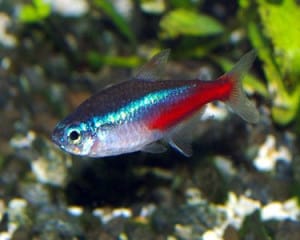
Common name: Neon Tetra, Neon
Scientific name: Paracheirodon Innesi
Average Adult Fish Size: 1.5 inches / 3.8 cm
Place of Origin: Native to south American blackwater rivers, such as the Solimoes river in south-eastern Colombia, eastern Peru and western Brazil.
Typical Tank setup: Well planted with rocks and driftwood/bogwood. They love playing in a moderate to strong current.
Recommended Minimum Aquarium Capacity: 10 gallon / 40 litre
Compatibility: It is very common to find neon tetras with Corydoras as companions, as they are both quite peaceful and other tank mates like Guppies, other Tetras, Rasboras, Mollies & Platies
Temperature: 65 – 80 Deg F / 18 – 27 Deg C This hardy species is well suited for unheated aquariums.
Water chemistry: pH 5.0 – 7.8
Feeding: They are omnivorous and do very well on a varied diet of quality flake foods, micro pellets, daphnia, microworms, and brine shrimp.
Sexing: It is difficult to sex young Neon’s but the female should be rounder and thus the blue line should curve a bit more.
Breeding: Males are slimmer and have a straighter blue line along the side. Water temperature of 25°c, very soft water of PH 5 or lower and subdued lighting. The eggs are laid over fine leaved plants and hatch in 24 hours. Feed the newly hatched fry on fine live food infusoria or liquid food for 10-12 days. They should then be able to feed on newly hatched brine shrimp.
Additional Information: These fish are generally sold as starter fish, however they are quite a delicate species and in general will not survive in a tank that has not been properly established, popular belief is that the water parameter acceptable range is rather narrow but these fish can survive.
Neon tetra disease: this disease is named after neon tetras since it was first diagnosed on this species however it can spread to other species, first signs of the disease is “not shoaling” with the other fish, there is no known cure for this disease which is caused by a parasite which enters the body of the fish through the mouth and burrows itself in the walls of the gut of the fish before attacking its muscles producing cysts, (this is the stage where you first notice white patches, the only thing you can actually do is to remove the fish from the tank.


Related Posts
Croaking Gourami – Trichopsis vittatus
Benthochromis Tricoti
Large-eyed Mouthbrooder – Callochromis Macrops